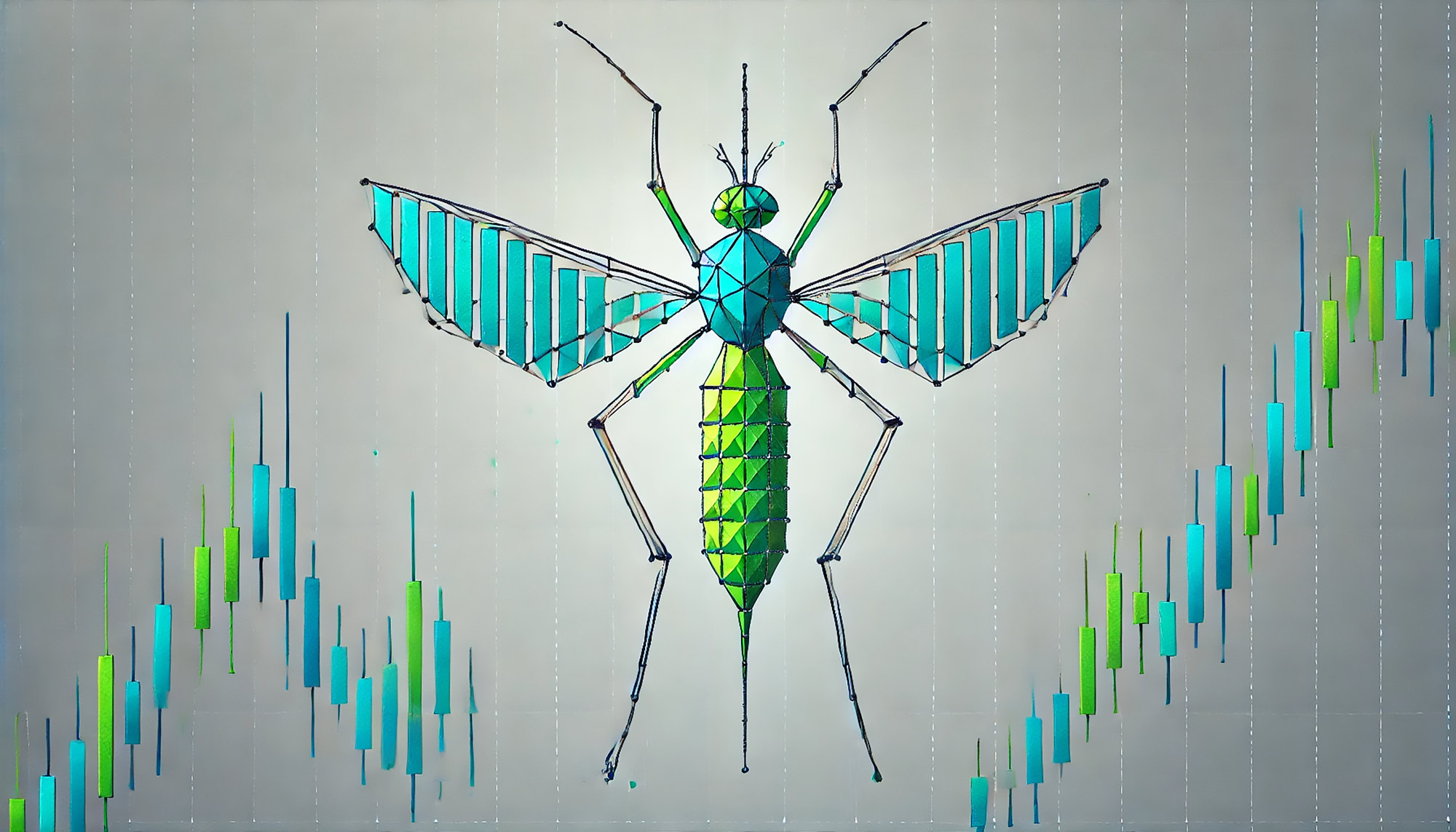Learn how to identify and trade the Dragonfly Doji candlestick pattern for potential market reversals, enhancing your trading strategies.
A Dragonfly Doji is a candlestick pattern that signals potential trend reversals in financial markets. It forms when the open, high, and close prices are nearly the same, creating a "T" shape with a long lower shadow and no upper shadow. Here's what you need to know:

- What It Means: Indicates market indecision, where sellers initially dominate, but buyers regain control by the session's end.
- Key Scenarios:
- End of a Downtrend: Suggests a possible bullish reversal.
- Near Support: Confirms strong support and potential upward movement.
- Close to Resistance: Warns of weakening momentum and possible reversal.
- Confirmation: Always wait for a bullish follow-up candle closing higher than the Doji to confirm the signal.
- Risk Management: Use stop-loss orders just below the Doji's low for long positions or above the high for short trades.
For better accuracy, combine the Dragonfly Doji with volume data and technical indicators like RSI or moving averages. This layered approach can help you identify stronger setups and avoid false signals.

Identifying and Interpreting Dragonfly Doji Patterns
Characteristics of a Dragonfly Doji
A Dragonfly Doji forms a distinct 'T' shape with a tiny body, no upper shadow, and a long lower shadow. This pattern shows strong buying momentum after initial selling pressure. The key detail? The lower shadow must be at least twice the size of the body. This signals buyers stepping in and recovering after significant selling. Recognizing these traits is essential for understanding how this pattern plays out in different market scenarios.

Role in Market Trends
The impact of a Dragonfly Doji depends on where it appears in the market:
- At the End of a Downtrend: Suggests a potential bullish reversal. Watch for a bullish candle to confirm the shift.
- Near a Support Level: Reinforces the strength of the support. A long position with a tight stop-loss might be worth considering.
- Close to Resistance: Signals possible trend weakness. Be ready for a reversal.
When paired with higher trading volume, the pattern becomes more reliable, as it confirms strong buyer activity.
Avoiding Common Mistakes
While the Dragonfly Doji can be a valuable signal, it’s easy to misinterpret. Here are some common errors to watch out for:
- Confusing It with Other Patterns: Unlike the Hammer, a Dragonfly Doji has no upper shadow and a longer lower shadow, making it a more pronounced bullish signal.
- Skipping Context and Confirmation: Jumping into trades without considering the broader market context can lead to poor results. Always evaluate:
- The overall market trend
- Key support and resistance levels
- Volume spikes
- Signals from other technical indicators
- Whether a bullish follow-up candle closes above the Dragonfly Doji
For better accuracy, combine this pattern with other technical tools and volume analysis. This layered approach increases the odds of making successful trades.
Trading Strategies Using Dragonfly Doji
Confirming with Follow-Up Candles
To trade effectively with a Dragonfly Doji, you need confirmation from the next candle. A bullish signal is confirmed when the following candle closes higher than the Doji's close price, indicating sustained buying pressure. Ideally, this follow-up candle should show strong momentum in the anticipated direction, with its body at least matching the length of the Dragonfly Doji's lower shadow.
Focus on Dragonfly Doji patterns that appear near support levels or at the end of a downtrend. These areas are more likely to result in a successful reversal when paired with proper confirmation. Adding volume analysis can further increase the reliability of the signal.
Incorporating Volume Data
Volume plays a crucial role in validating Dragonfly Doji patterns. High trading volume during the Doji's formation and increasing volume on the confirmation candle are strong indicators of buyer strength and potential trend reversal.
| Volume Characteristic | What It Indicates |
|---|---|
| Higher-than-average volume on Doji day | Strong buying interest at that price level |
| Rising volume on confirmation candle | Reinforces the likelihood of a reversal |
| Consistent volume in subsequent days | Signals a more durable trend change |
Using Additional Indicators
To improve the accuracy of Dragonfly Doji signals, combine them with other technical indicators. This approach provides a more comprehensive analysis and reduces the chance of false signals.
Here are some effective combinations:
- Moving Averages: Look for Dragonfly Doji patterns near key levels like the 50-day or 200-day EMA for added significance.
- RSI (Relative Strength Index): If the RSI is below 30 when the Dragonfly Doji appears, it suggests oversold conditions, enhancing the reversal signal.
- Stochastic Oscillators: These can confirm whether the market is oversold, aligning with the Dragonfly Doji's potential.
For traders seeking advanced tools, platforms like LuxAlgo can help refine pattern recognition and minimize false signals. LuxAlgo leverages AI to integrate these indicators, offering more precise insights for decision-making.
Risk Management and Common Mistakes
Setting Stop Losses
For long trades, set your stop loss just below the Dragonfly Doji's lower shadow. For short trades, place it slightly above the Doji's high. This approach helps limit potential losses if the reversal doesn't pan out, while staying true to the structure of the pattern. Once your stop-loss is in place, evaluate whether the trade offers a reasonable risk/reward balance.
| Position Type | Stop Loss Placement | Reason |
|---|---|---|
| Long Position | Below Doji low | Protects against a failed reversal |
| Short Position | Above Doji high | Shields from an upward breakout |
Assessing Risk/Reward Ratios
Before jumping into a trade based on a Dragonfly Doji, take the time to calculate your risk/reward ratio. Aim for at least a 2:1 reward-to-risk ratio. For instance, if you're risking $5 per share on a stop loss, your target profit should be no less than $10 per share.
In volatile markets, you might need to set wider stop losses, but this also opens the door to larger potential gains. Tools like LuxAlgo's indicators can guide you in identifying profit targets by analyzing past price movements and volatility trends.
Avoiding Overtrading and Bias
The Dragonfly Doji can be a strong signal, but trading it without proper confirmation can lead to unnecessary losses. Focus on setups that align with key support or resistance levels, confirm with volume, and fit within the broader market context.
Equally important is managing your position size. Limit your risk to 1-2% of your total trading capital for any single Dragonfly Doji trade. No matter how convincing the setup looks, this disciplined strategy helps safeguard your account from major losses if the trade doesn't work out.
Using Advanced Tools for Analysis
LuxAlgo: A Boost for Technical Analysis
How LuxAlgo Premium Indicators Help
LuxAlgo Premium indicators can be used alongside the Dragonfly Doji pattern to create stronger confluence for an entry. By combining multiple real-time signals—such as trend detection, volume-based triggers, and momentum readings—traders gain a clearer picture of market conditions. This synergy can help confirm whether the Dragonfly Doji is likely to result in a significant reversal or if further confirmation is needed before placing a trade.
AI-Powered Strategy Refinement
LuxAlgo’s AI backtesting assistant allows traders to test and validate their overall strategies using historical data. By reviewing performance metrics across various market conditions, traders can refine their entry and exit rules, manage risk more effectively, and build greater confidence in their trading plans.
Community and Learning Opportunities
The LuxAlgo community provides a platform for traders to exchange insights and access expert advice. These resources help traders sharpen their skills in recognizing Dragonfly Doji patterns while emphasizing the importance of risk management and understanding market dynamics.
While advanced tools like LuxAlgo can streamline the process, they work best when paired with traditional technical analysis. Success still depends on disciplined risk management and thorough market evaluation.
Conclusion: Using Dragonfly Doji for Trade Entries
The Dragonfly Doji provides traders with a clear way to spot potential market reversals. Its distinct "T" shape highlights strong buying pressure, setting it apart from patterns like the Hammer.
To use this pattern effectively, focus on validating the setup, managing risk, and identifying key technical support levels. For those looking to refine their analysis, tools such as LuxAlgo can be a helpful addition. These tools enhance the process by offering precise pattern detection and confirmation across different timeframes.
With features like advanced indicators and AI-driven analysis, LuxAlgo simplifies the interpretation of Dragonfly Doji patterns. This makes it easier for traders to confirm reversal signals while sticking to solid trading strategies.
Quality setups should always take precedence over quantity. While the Dragonfly Doji doesn't appear often, its importance in identifying reversals makes it a valuable tool when combined with modern analysis tools and disciplined risk management.








